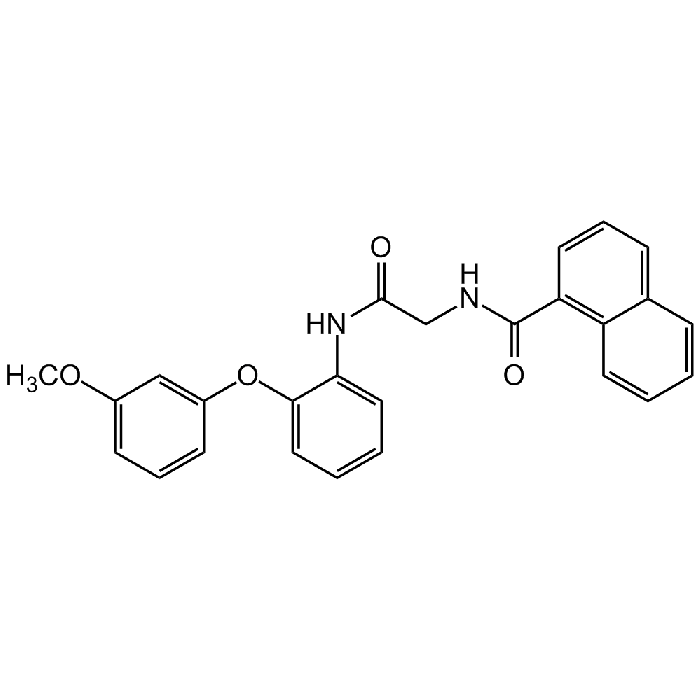Cookie Policy: This site uses cookies to improve your experience. You can find out more about our use of cookies in our Privacy Policy. By continuing to browse this site you agree to our use of cookies.
AdipoGen Life Sciences
AOH1996
As low as
95
CHF
CHF 95.00
In stock
Only %1 left
AG-CR1-3553-M0055 mgCHF 95.00
AG-CR1-3553-M02525 mgCHF 285.00
Research Use Only (RUO). NOT ALLOWED FOR USE IN HUMANS.

| Product Details | |
|---|---|
| Synonyms | NSC789796; N-(2-((2-(3-Methoxyphenoxy)phenyl)amino)-2-oxoethyl)-1-naphthamide |
| Product Type | Chemical |
| Properties | |
| Formula |
C26H22N2O4 |
| MW | 426.5 |
| CAS | 2089314-64-5 |
| Purity Chemicals | ≥98% (HPLC) |
| Appearance | White to off-white solid. |
| Solubility | Soluble in DMSO (10mg/ml). |
| Identity | Determined by 1H-NMR. |
| InChi Key | HDMONPHKMIZXDH-UHFFFAOYSA-N |
| Smiles | O=C(CNC(C1=C(C=CC=C2)C2=CC=C1)=O)NC3=CC=CC=C3OC4=CC(OC)=CC=C4 |
| Shipping and Handling | |
| Shipping | AMBIENT |
| Short Term Storage | +4°C |
| Long Term Storage | -20°C |
| Handling Advice | Keep cool and dry. |
| Use/Stability | Stable for at least 2 years after receipt when stored at -20°C. |
| Documents | |
| MSDS |
 Download PDF Download PDF |
| Product Specification Sheet | |
| Datasheet |
 Download PDF Download PDF |
Description
- AOH1996 is an orally available and metabolically stable small molecule PCNA inhibitor, which selectively kills cancer cells, with a median concentration of about 300 nM for 50% growth inhibition. AOH1996 was not significantly toxic to non-malignant cells, even up to 10 µM.
- AOH1996 enhances the interaction between PCNA and the largest subunit of RNA polymerase II (RNAPII), RPB1, and dissociates PCNA from actively transcribed chromatin regions, while inducing DNA double-stranded breaks in a transcription-dependent manner, leading to the overall degradation of RPB1 and the collapse of replication forks in actively transcribed regions.
- AOH1996 was created to target a post-translationally modified isoform of PCNA, termed caPCNA, which is preferentially found in cancer cells. PCNA is crucial in the body for DNA repair, but targeting it is difficult because of its role in healthy cells. By selectively targeting caPCNA, it may be possible to kill cancer cells without affecting healthy tissues. In vitro testing demonstrated that AOH1996 inhibited the growth and induced cell cycle arrest (G2/M or S phase arrest) and apoptotic cell death in a wide variety of cancer cell lines, but had no effect on several normal, nonmalignant cell types.
Product References
- The Anticancer Activity of a First-in-class Small-molecule Targeting PCNA: L. Gu, et al.; Clin. Cancer Res. 24, 6053 (2018)
- Small molecule targeting of transcription-replication conflict for selective chemotherapy: L. Gu, et al.; Cell Chem. Biol. (Epub ahead of print) (2023)
- Arginine shortage induces replication stress and confers genotoxic resistance by inhibiting histone H4 translation and promoting PCNA ubiquitination: Y.-C. Wang, et al.; Cell Rep. 42, 112296 (2023)
- Therapeutic Targeting of DNA Replication Stress in Cancer: L. Gu, et al.; Genes 14, 1346 (2023) (Review)





